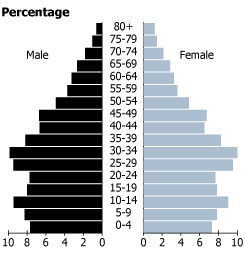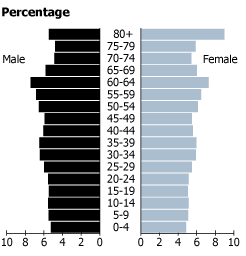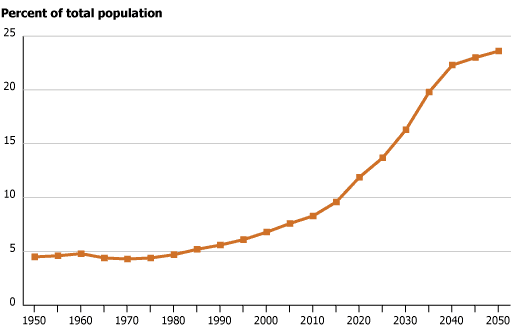Toshiko Kaneda
Technical Director, Demographic Research

As late as 25 years ago, China was concerned it had too many children to support. Today, however, China faces the opposite problem: as a result of the success of its “one-child” policy, the country faces the prospect of having too few children to support a rapidly aging population (see Figure 1 for China’s projected aging trend between 2000 and 2050).

Source: World Population Prospects: The 2004 Revision (2005).

Source: World Population Prospects: The 2004 Revision (2005).
The dramatic fertility decline and improved longevity over the past two decades are causing China’s population to age at one of the fastest rates ever recorded, accompanied by an increase in the prevalence of chronic disease and disability in the population.
Meeting the health and long-term care needs of this growing elderly population will result in soaring health care costs—and with a shrinking working-age population to help pay the bill. Indeed, the challenge of paying for health care in China is immense, especially since the Chinese health care system has already experienced large increases in overall costs and greater private expenditure since shifting to a market-oriented system in the early 1980s.1
But while China is not prepared to meet the health needs of its growing elderly population, its government has recognized these challenges and is starting to develop a comprehensive response. As a first step, Chinese health officials have implemented various chronic-disease prevention programs at the national level. They are also starting to set up long-term care delivery systems for the elderly. But while China’s economy continues to grow rapidly, whether it will be able to allocate enough income to meet these rising health care costs remains as a major concern.
China has made vast improvements in health over the past five decades, with life expectancy at birth increasing by two-thirds from 40.8 to 71.5 between 1955 and 2005.2 The country already has about 102 million elderly (those ages 65 and over), or over one-fifth of the world’s elderly population.3 And the percentage of elderly in China is projected to triple from 8 percent to 24 percent between 2006 and 2050, to a total number of 322 million (see Figure 2).4

Because chronic health problems become more common in old age, China’s population aging has led to increases in the country’s prevalence of chronic disease and disability, creating a greater need for long-term care. And improved living standards in China have exacerbated the epidemic of chronic disease by increasing exposure to major risk factors such as smoking, high-fat and high-calorie diets, and more leisure time without physical activity.
Chronic diseases accounted for almost 80 percent of all deaths in China in 2005, with the major causes being cardiovascular disease, cancer, and chronic respiratory diseases.5 Hypertension prevalence in adult population (currently 19 percent) has increased by one-third over the past decade.6 Prevalence of obesity, though still around 7 percent, has almost doubled in a decade. These trends suggest potential increases in the prevalence of these conditions for future cohorts of China’s elderly.
The rate of increase in health care costs has already exceeded the growth of the national economy and individual earnings.7 Long-term care for the elderly, traditionally provided at home in China by adult children (especially by daughters-in-law), will become increasingly less feasible in coming decades when parents of the first generation of the one-child policy start reaching old age and retiring. These singletons will face the need to care for two parents and often four grandparents without siblings with whom to share the responsibility, a problem sometimes referred to in China as the “4-2-1 problem.”
And the macro-level outlook for health care spending is no better. While the number of elderly in the population who require care is growing, the size of the working-age population (who pay much of the health care costs) is shrinking. The elderly-support ratio—the working-age adult (ages 15 to 64) per number of elderly (age 65 and above)—is projected to decline drastically, from 9 persons to 2.5 persons by 2050.8
This demographic shift is troublesome for a health care system that already faces a number of challenges—most important of which is the rapid increase in overall costs and in private health care spending.9 The health care system in China—once regarded as exemplary for low-income agrarian societies—has degenerated considerably in access since the early 1980s at the same time as its costs have soared. A system that relied heavily on public subsidies and provided egalitarian access to basic health care has shifted to a market-oriented system that relies heavily on private funding and is characterized by excessive usage fees.
Now, rising out-of-pocket costs prevent many Chinese from seeking early care and have resulted in wide disparities in health care access, particularly between urban and rural areas. These trends are of particular concern to the elderly, who likely have higher health care needs yet less means to afford that care, and who also make up larger proportion of the rural population than the younger population.
The Chinese government has only recently acknowledged the consequences of rapid population aging and has started to address them in various policies and programs:
Strategies for long-term care. Though public funding for the long-term care of the elderly in China is still limited, the Chinese government has started to allocate more funding in this area.10 At the same time, new opportunities for entrepreneurship in the health service industry have opened—a result of China’s social-welfare reform in the 1990s, which decentralized government-funded welfare institutions and significantly reduced their government financing.11
Today, an increasing number of private elder homes as well as the country’s former government-sponsored elder homes (which used to be reserved exclusively for elderly with no children and no other means of support) are providing an alternative to familial elder care.12 However, these facilities are still small in number, of varying standards, and are often too expensive for many elderly and their families.
Community-based long-term care services for the elderly in China—both informal and local government-supported—have also begun to emerge, especially in urban areas.13 These efforts are serving various needs of the elderly and their family caregivers, including daily care, home maintenance, and information and referral services.14
The lack of a trained workforce in caregiving to elderly is an important issue facing China’s long-term care delivery system.15 Some local government agencies (such as the labor union and the department of health) are training laid-off workers to work in long-term care—but these training programs are short and cover only limited basic caregiving skills.
Some observers are calling for more knowledge-based training programs that offer a broader range of caregiving skills. Besides long-term care, the government has plans to develop geriatric medical training at an undergraduate level and to establish more geriatric units to increase the country’s capacity to address the specific health care needs of the elderly.16
Strategies for primary and secondary prevention. China’s ministry of health has also been addressing chronic disease prevention and control. In 2002, for instance, it established the National Center for Chronic and Non-Communicable Disease Control and Prevention to oversee efforts at the national level; the same year, it unveiled the Disease Surveillance Points System, a national resource for chronic disease surveillance.17
The ministry is also working to develop the first long-term (from 2005 to 2015) comprehensive national plan for chronic disease control and prevention in cooperation with relevant sectors and supported by the World Health Organization (WHO). Reducing adult male smoking, hypertension, overweight and obesity, and building capacity for chronic disease control are among the plan’s highest priorities.
Programs targeted toward specific diseases have also increased. These efforts include a community-based intervention on management of hypertension and diabetes conducted in three cities (Beijing, Shanghai, and Changsha) between 1991 and 2000; a national cancer control plan, the Program of Cancer Prevention and Control in China; and ratification of the WHO Framework Convention of Tobacco Control. Furthermore, to prevent chronic disease at early ages, projects to improve nutrition and health status have been undertaken. These projects are focused mainly on primary schools and have achieved encouraging reductions (by as much as 30 percent in one year in one example) in the prevalence of childhood obesity.18
The challenges of population aging are daunting for any country, but especially so for China. Unlike developed countries where economic development preceded population aging, China faces the massive demands of population aging at one of the fastest rates ever and while its economy is still not fully developed—hence, without the funds necessary to address the demands. China’s dilemma is how to allocate resources among competing needs of various sectors while still continuing its economic growth.
In addition to the 4-2-1 problem, trends in both the female labor-force participation and the sex ratio of young Chinese may well create additional issues for a society which traditionally has left elder care to its women, especially daughters-in-law. The labor-force participation among young Chinese women is very high and could affect the informal provision of long-term care in the coming decades. The sex ratio at birth for the young cohorts born after China’s one-child policy is highly skewed toward boys, potentially creating a future deficit of daughters-in-law as elder caregivers.19
While the trend of population aging is inevitable and can even be accelerated by further declines in mortality and fertility, stemming the epidemic of chronic disease is one promising way to reduce the overall impact of aging on China’s social and economic development. Investing in a formal long-term care system to complement the informal care currently provided primarily by family members could also encourage their continued participation in the provision of care. Addressing these elder care challenges will be crucial to China’s continued social and economic development and stability.
